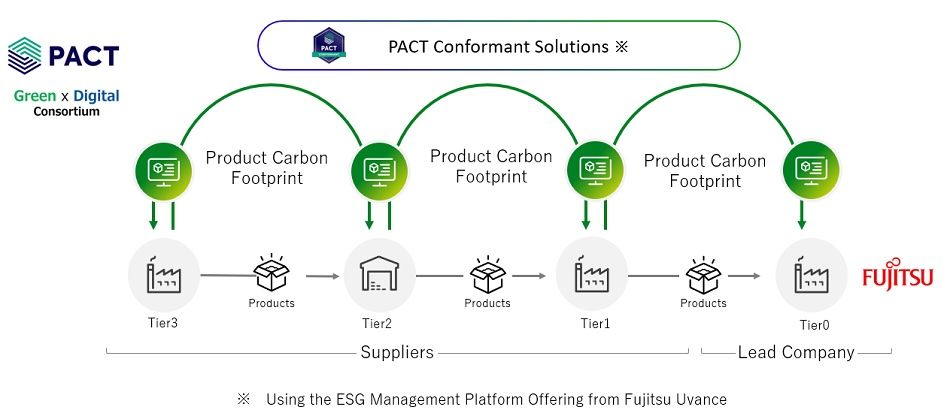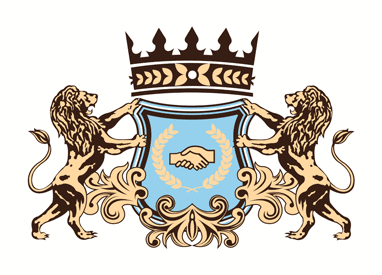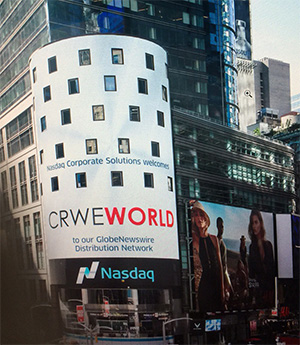Fujitsu collaborates with global suppliers in decarbonization initiative to exchange product-level primary data on CO2 emissions

News Facts:
- Collaboration with 12 global suppliers to calculate and exchange CO2 emissions data, using a PACT -conformant solution with global standards
- Fujitsu's innovative offering enables transparent and reliable data exchange for calculating product carbon footprints at both product and organizational levels, allowing for visualization and reduction of emissions across the entire supply chain
- Initiative conformance to global standards, including the PACT Methodology, and demonstrates interoperability with solutions from multiple international partners, showcasing Fujitsu's commitment to achieving net-zero emissions across value chains by 2040
KAWASAKI, Japan, Nov 15, 2024 - (JCN Newswire) -Fujitsu today announced that it has started an initiative on decarbonization with global suppliers leveraging product-level data exchange on CO2 emissions. The initiative represents part of Fujitsu’s efforts to achieve net zero CO2 emissions (1) across its entire value chain (Scope 3) by 2040.
To achieve these decarbonization goals, since fiscal 2024, Fujitsu has been deepening its engagement with suppliers, implementing data exchange between companies using product carbon footprint (PCFs) with actual data to visualize and reduce CO2 emissions from purchased parts and materials.
The initiative leverages Fujitsu's ESG Management Platform, a solution that supports the realization of corporate ESG management by visualizing, measuring, and optimizing CO2 emission reductions. Fujitsu is working with a total of 12 global suppliers (2), including Accton Technology Corporation, KAGA FEI Co., Ltd., NEXTY Electronics Corporation, Schneider Electric, Hakuto Co., Ltd., Furukawa Electric Co., Ltd., MiTAC Holdings Corporation, Lumentum Holdings Inc. and others, to achieve PCF calculation and CO2 emissions data exchange using actual data in accordance with global standards.
Fujitsu, drawing from its experience and insights as a core member in the rule-making process around PCF calculation and product-level data exchange across value chains both in Japan and internationally, is well-versed in the progress of each supplier's decarbonization efforts and industry-specific challenges.
As part of this initiative, in addition to the globally standardized product-based PCF calculation methodology (3) and product-level data on CO2 emissions exchange, Fujitsu successfully implemented the world's first offering that enables organization-based PCF calculation methodology (4) and data exchange, which are more prevalent among suppliers, using actual data for social implementation.
Furthermore, to address suppliers' concerns about possible leakage of confidential information (i.e., product design details) in promoting CO2 emissions data exchange between companies Fujitsu’s ESG Management Platform ensures transparency and reliability through a highly confidential decentralized data management model that limits access rights to PCF calculations and connects only PCF data via an API (Application Programming Interface).
By linking the CO2 emissions of suppliers from upstream in the supply chain, the platform enables the visualization of the effects of CO2 emission reduction measures, such as the introduction of renewable energy implemented by suppliers.
This makes the CO2 emission reduction efforts across the entire supply chain visible as value, which can then be reflected in CO2 emission reduction scenarios for decarbonization and simulations of the effectiveness of measures.
Fujitsu will continue to support a wide range of clients, including manufacturers, by combining and analyzing non-financial data such as CO2 reduction efforts with financial data including sales data, and contribute to the realization of a decarbonized supply chain.
Fujitsu will report on this initiative at the ICT×Green Seminar hosted by the Japanese Ministry of Internal Affairs and Communications at the Japan Pavilion during COP29 on November 16, 2024, and will also discuss the advanced initiatives of Japanese companies.
Takeshi Ogamino, Corporate Vice President, General Manager, FITEL Products Division, Communications Solutions Division, Furukawa Electric Co., Ltd., comments:
“I am truly delighted that the collaboration with Fujitsu on carbon footprint data integration has been successful. Fujitsu has provided us with guidance on data integration and solutions compliant with PACT, enabling us to integrate the carbon footprint of our communication semiconductor laser products and advance new initiatives to reduce GHG emissions across the entire value chain. Looking ahead, we will continue to contribute to further GHG emission reductions, aiming for carbon neutrality by 2050 and societal transformation, to realize a sustainable future.”
Xavier Denoly, Senior Vice President, Sustainable Development, Schneider Electric, comments:
“Schneider Electric is working to reach net zero CO2 emissions throughout its entire supply chain, and we are pleased to work in collaboration with Fujitsu on these challenges. To help solve issues, it is important to use global standards to facilitate cooperation across the value chain.”
PCF calculation and data exchange leveraging Fujitsu‘s ESG Management Platform
The PCF calculation method on the ESG Management Platform used for this initiative leverages the “PACT Methodology” (5) and conformant to Japan’s “Green x Digital Consortium CO2 Visualization Framework (Edition 2.0.1)” powered by Japan Electronics and Information Technology Industries Association (JEITA) (6). In terms of data integration on the ESG Management Platform, it has passed interoperability tests conducted by PACT with solutions from the Digital Sustainability Cloud (DSC) of Institute for Information Industry, III in Taiwan (7) and Evalue8 Sustainability in Australia (8), and has been certified as a PACT-conformant solution in conformance to the tech specification of the "Pathfinder Framework (Version 2.2.0)" (9) as the globally standard. Utilizing the PACT-conformant solution enables data exchange on CO2 emissions between companies across countries. Moving forward, it will be possible to smoothly implement data exchange with companies based in Europe, the United States, Taiwan, and Australia. Furthermore, this data exchange also conformant to the "Green x Digital Consortium Technical Specifications for Data Exchange (Version 2.0)"..
Figure: Using the ESG Management Platform Offering from Fujitsu Uvance
Future Plans
Fujitsu will continue to actively engage in visualizing and implementing measures to reduce CO2 emissions in the supply chain by leveraging technologies such as data and AI, while also providing the know-how gained through practice to customers and society via its ESG Management Platform.
As part of Fujitsu Uvance, Fujitsu's business model to solve societal issues, Fujitsu will contribute to the realization of a sustainable supply chain and global carbon neutrality.
Fujitsu will also continue to cooperate with industry organizations including the WBCSD (10) to support efforts towards rule-making aimed at achieving net-zero CO2 emissions across the entire value chain, responding to updates in global standard specifications, and strengthening supplier engagement.
(1) Net zero CO2 emissions:
Balancing residual emissions with the same amount of neutralization. Fujitsu aims to reduce CO2 emissions by more than 90% from the base year of 2020 by the target year of 2040. The remaining emissions of 10% or less are planned to be removed and stored through technologies that directly capture CO2 emissions from the atmosphere and absorption through afforestation.
(2) 12 global suppliers:
Accton Technology Corporation: Headquartered in Hsinchu, Taiwan, Chairperson Kuo-Hsiu Huang
KAGA FEI Co., Ltd.: Headquartered in Kanagawa Prefecture, Japan, Representative Director, President Takeshi Tsukamoto
NEXTY Electronics Corporation: Headquartered in Tokyo, Japan, Representative Director, President Yasuhiro Kakihara
Schneider Electric: Headquartered in Rueil-Malmaison, France, Chief Executive Officer Olivier Blum
Hakuto Co., Ltd.: Headquartered in Tokyo, Japan, Representative Director, President and Chief Executive Officer Tamaki Miyashita
Furukawa Electric Co., Ltd.: Headquartered in Tokyo, Japan, President (Representative) Hideya Moridaira
MiTAC Holdings Corporation: Headquartered in Taoyuan, Taiwan, Chairman Matthew Miau
Lumentum Holdings Inc.: Headquartered in California, United States, President and Chief Executive Officer Alan Lowe
(3) Product-based PCF calculation methodology:
Method of calculating PCF based on the life cycle inventory analysis of greenhouse gases for each product. Requirement in PACT under global standards.
(4) Organization-based PCF calculation methodology:
Method of allocating Scope 1, 2, and 3 data as an organization by delivery amount, etc., for each delivery destination. Recognized as a transitional calculation method in the "Green x Digital Consortium CO2 Visualization Framework (Edition 2.0.1)" powered by JEITA(Japan Electronics and Information Technology Industries Association) and is proposed as an extension of PACT.
(5) PACT Methodology:
Guidance indicating the methodology for calculating and exchanging CO2 emission data.
Previously, it was called Pathfinder Framework. The PACT Methodology builds on existing frameworks and standards to provide guidance on accounting, verification, and exchange of cradle-to-gate PCFs with the aim of creating more accurate, granular, and comparable emissions data. The PACT Methodology can be accessed here, with v 3.0 of the methodology and tech specs due to be released in Q1 2025.
(6) Green x Digital Consortium CO2 Visualization Framework (Edition 2.0.1):
Product carbon footprint calculation rules compiled by the Green x Digital Consortium Visualization WG.
(7) Institute for Information Industry, III:
Headquartered in Taipei City, Taiwan, DTRI Senior Deputy Director General Hubert Wang
(8) Evalue8 Sustainability:
Headquartered in Canberra, Australia
(9) The tech specification of the Pathfinder Framework (Version 2.2.0):
International technical specification for confidential and secure data exchange of emission data between companies based on solution interoperability. Solutions conformance to this technical specification are listed as PACT-conformant solutions in the PACT online catalog.
(10) World Business Council for Sustainable Development (WBCSD):
Organization led by CEOs of approximately 230 global companies aiming to achieve a sustainable society through business activities, with Fujitsu serving as a board member.
About Fujitsu
Fujitsu’s purpose is to make the world more sustainable by building trust in society through innovation. As the digital transformation partner of choice for customers in over 100 countries, our 124,000 employees work to resolve some of the greatest challenges facing humanity. Our range of services and solutions draw on five key technologies: Computing, Networks, AI, Data & Security, and Converging Technologies, which we bring together to deliver sustainability transformation. Fujitsu Limited (TSE:6702) reported consolidated revenues of 3.7 trillion yen (US$26 billion) for the fiscal year ended March 31, 2024 and remains the top digital services company in Japan by market share. Find out more: www.fujitsu.com.
Press Contacts:
Fujitsu Limited
Public and Investor Relations Division
Inquiries
Copyright 2024 JCN Newswire. All rights reserved. www.jcnnewswire.com
© 2024 JCN Newswire. All rights reserved. A division of Japan Corporate News Network.




















